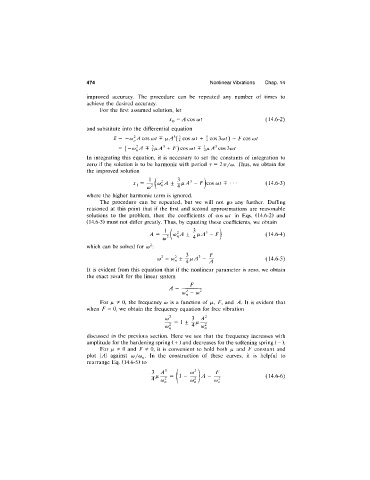Page 487 - Thomson, William Tyrrell-Theory of Vibration with Applications-Taylor _ Francis (2010)
P. 487
474 Nonlinear Vibrations Chap. 14
improved accuracy. The procedure can be repeated any number of times to
achieve the desired accuracy.
For the first assumed solution, let
Xn = A COS (iJt (14.6-2)
and substitute into the differential equation
X = —(o^A cos cot T cos cot + \ cos 3cot) + F cos cot
= ( T \i±A^ -h F) cos cot T \ixA^ cos 3cot
In integrating this equation, it is necessary to set the constants of integration to
zero if the solution is to be harmonic with period r = 2rr/co. Thus, we obtain for
the improved solution
± ¡ isA ’ - f )COS cot (14.6-3)
where the higher harmonic term is ignored.
The procedure can be repeated, but we will not go any further. Duffing
reasoned at this point that if the first and second approximations are reasonable
solutions to the problem, then the coefficients of cos cot in Eqs. (14.6-2) and
(14.6-3) must not differ greatly. Thus, by equating these coefficients, we obtain
^ ( 2
A ± f ) (14.6-4)
CO \
which can be solved for
2 2 ^ a 2 ^
Ù) - ± -rfiA - (14.6-5)
A
It is evident from this equation that if the nonlinear parameter is zero, we obtain
the exact result for the linear system
A =
For (L ^ 0, the frequency w is a function of ja, F, and It is evident that
t
when F = 0, we obtain the frequency equation for free vibration
co^ ^ A^
2 “ 1 ± 4 M 2
discussed in the previous section. Here we see that the frequency increases with
amplitude for the hardening spring ( -f ) and decreases for the softening spring ( - ).
For 0 and F F 0, it is convenient to hold both ¡jl and F constant and
plot \A\ against co/co^. In the construction of these curves, it is helpful to
rearrange Eq. (14.6-5) to
3 A^ caM F
TM — = 1 ------^ M ------1 (14.6-6)
^ (Ot \ M„ wt

